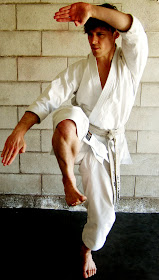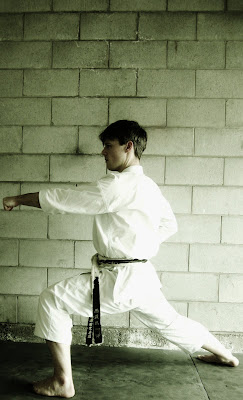 I know you have read them numerous times before; nevertheless, each of the following '20 Precepts of Karate-Do' (written by Funakoshi Gichin Sensei) are always worthy of reflection.
I know you have read them numerous times before; nevertheless, each of the following '20 Precepts of Karate-Do' (written by Funakoshi Gichin Sensei) are always worthy of reflection._________
1. Karate begins with courtesy and ends with courtesy.
2. There is no first attack in Karate.
3. Karate is an aid to justice.
4. First control yourself before attempting to control others.
5. Spirit first, technique second.
6. Always be ready to release your mind.
7. Accidents arise from negligence.
8. Do not think that Karate training is only in the dojo.
9. It will take your entire life to learn Karate; there

is no limit.
10. Put your everyday living into Karate and you will find "Myo" (subtle secrets).
11. Karate is like boiling water. If you do not heat it constantly, it will cool.
12. Do not think that you have to win, think rather that you do not have to lose.
13. Victory depends on your ability to distinguish vulnerable points from invulnerable ones.
14. The battle is according to how you move guarded and unguarded
(move according to your opponent).
15. Think of your hands and feet as swords.
16. When you leave home, think that you have numerous opponents waiting for you.
It is your behavior that invites trouble
from them.

17. Beginners must master low stance and posture, natural body positions are for the advanced.
18. Practicing a kata is one thing, engaging in a real fight is another.
19. Do not forget to correctly apply: strength and weakness of power,
stretching and contraction of the body and slowness and speed of techniques.
20. Always think and devise ways to live the precepts every day.

© André Bertel. Christchurch, New Zealand 2011.
 I'm admittedly very sore from training today from ample shinshuku practice. Will need to stretch plenty tomorrow morning. Here is a newly uploaded video on Youtube.
I'm admittedly very sore from training today from ample shinshuku practice. Will need to stretch plenty tomorrow morning. Here is a newly uploaded video on Youtube.






























